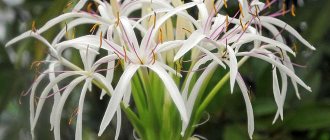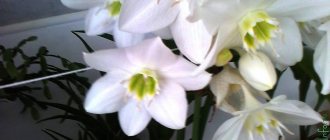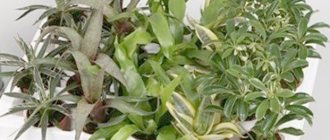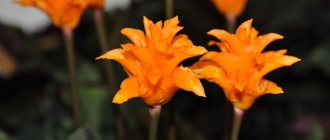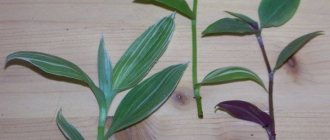Author: Elena N. https://floristics.info/ru/index.php?option=com_contact&view=contact&id=19 Category: Houseplants Published: June 22, 2017Last edits: January 11, 2021
- Cuttings
- Pests and their control
- Hatiora salicornioides
Hatiora (lat. Hatiora) is a genus of epiphytic cacti from the tropical forests of Brazil, numbering, according to various sources, from five to ten species, some of which are grown indoors. Some taxonomists include Hatiora in the genus Rhipsalis. At first, the genus was named “Hariota” in honor of Thomas Harriot, a famous English mathematician and traveler who was one of the first explorers of the nature of America. But then it turned out that this name had already been assigned to another plant, and it was necessary to use an anagram: chariota - hatiora.
Planting and caring for hatiora
- Flowering: April or May with terminal flowers of red, yellow or pink.
- Lighting: bright sunlight, on southern windowsills - with shading in the afternoon.
- Temperature: in the warm season – 18-25 ˚C, in winter – 12-14 ˚C. The difference between day and night temperatures should be 5-6 degrees.
- Watering: moderate: between two waterings the top layer of the substrate should dry out. During the dormant period, the substrate is moistened less frequently - approximately once every 3 weeks. Half an hour after watering, be sure to drain excess water from the pan.
- Air humidity: does not matter: hathiora is a succulent.
- Feeding: from spring to autumn 2 times a month with complex mineral fertilizers that do not contain calcium and with a reduced amount of nitrogen. In other months, no fertilizing is applied.
- Rest period: not clearly expressed.
- Pruning: to maintain decorativeness, excess segments are plucked off by hand in early spring.
- Replanting: in spring, after flowering, at a young age - annually, in maturity - once every two to three years, and large specimens - once every five years.
- Reproduction: cuttings and grafting.
- Pests: scale insects, mealybugs and spider mites.
- Diseases: stem rot, late blight.
Read more about growing hatiora below.
Landing
Usually this procedure is carried out in the spring. Use soil mixture for cacti or succulents or a substrate prepared independently.
For hatiora, it is better to take a wide and not too deep container, since it has a shallow and branched root system.
Use a plastic or ceramic pot with drainage holes at the bottom. Fill in one handful of pebbles or expanded clay to ensure good drainage of moisture. The flowerpot is filled halfway with the substrate, the roots are lowered, straightened, sprinkled with soil to the top, compacted and watered.
Selection of location and soil
To plant this color you will need a light and loose substrate enriched with organic matter. You can use the mixture for planting cacti or succulent plants. You can also prepare the soil mixture yourself - mix peat with sand and turf soil in a ratio of 1:0.5:1.
The best location would be the southwest or west side of the house, where there is good diffused lighting. When grown in a south-facing window, shading will be required during the midday hours to avoid burns on the stems.
You should not keep the flower in the northern part, otherwise it will turn pale, grow slowly and may not bloom.
Botanical description
Hatiora cactus is a shrub with jointed stems. In some species of the genus, the segments are club-shaped, in others they are cylindrical or flat. What is the difference between hatiora and rhipsalis? Under natural conditions, the succulent hatiora grows in rock crevices and on stones, while the epiphyte rhipsalis prefers to settle in trees. Their external difference lies in the direction of growth of the stems: in hatiora they rise upward, while in rhipsalis the shoots droop. In addition, in hatiora the flowers are apical, pink, red or yellow, while in rhipsalis they are located along the entire length of the stem segment and are colored white or yellowish-white. In general, these plants are very close relatives and require the same conditions.
Popular varieties
A flower will decorate the interior
The genus includes 7 varieties of Hatiora.
Hermine (herminiae). The stems can be straight or slightly curved, up to 25-30 cm long, a rich shade of green. The flower grows up to 2 cm wide, the color is deep pink, even crimson. Hatiora germina grows in high mountain regions.
Salicornioide. It grows up to 80-100 cm, the color of the flowers is yellow, the stems are sagging, with short hairs at the areoles. hatiora salicornioides is often mistakenly called "salicornioides", but the correct name is "salicornioides".
Gartner (gaerneri). The stems are flat, with many segments and brown bristles along the edges. The type of Gartner or Gertner (these are synonymous names) reaches a height of 15-20 cm. It blooms with red bells elongated to 8 cm.
Pink (rosea). It may have blue and greenish flattened shoots with areoles on the sides where the hairs are located. The color of the buds is pink or bright crimson, the width of the bell is up to 4 cm.
Greser (graeseri ). It is characterized by flat stems and blood-red flowers, but breeders have developed other less common colors. A hybrid of two species - Gartner and pink.
All species require approximately similar maintenance rules, although in nature they are found in parts of Brazil with different weather conditions.
Similar plants
You should know that some types of different plants are confused with this cactus:
- Its close relative from the Cactus family, rhipsalis, is included in the Hatiora genus, but many flower lovers do not recognize this division, which is why confusion may arise. The differences in appearance are not obvious.
- It is difficult to distinguish the famous indoor flower from the hatiora - Schlumberger, or Decembrist. The main differences: the flowers of the Decembrist are one-sided, while those of the tropical cactus are symmetrical; the Decembrist grows actively in the summer and then blooms, while the hatiora first forms buds, and after falling, it grows green mass;
- Euphorbia Tirukalli is also often mistakenly included here, but it belongs to the Euphorbiaceae family, although it looks similar to Hatioraceae, its juice is poisonous and can cause allergies.
Caring for hatiora at home
Growing conditions
Caring for hatiora is easy. But first you need to find a decent place for it in the house. The hatiora plant will feel great on the windowsills of windows facing south, but the plant must be shaded from direct sunlight.
The main condition for good growth and development of hatiora is a noticeable difference between day and night temperatures. Hatiora is comfortable at 18-25 ºC. In the summer, it is advisable to arrange it on a balcony, terrace or in the yard, in the shade of a tree. In winter, in the room where the hatiora flower grows, the temperature should be within 12-14 ºC: it is at this time and in such conditions that the formation of flower buds occurs. Hatiora blooms in April or May.
- Ivy at home, types and varieties
Do not forget to ventilate the room where the plant is located, and in the hot season it must be sprayed, sometimes even twice a day: dry air makes the hatiora stems wrinkle and wither.
Pruning hatiora, or rather, forming hatiora, is done manually: excess segments are simply “unscrewed” from the stem.
Watering
Water the hathiora with settled or filtered water at room temperature when the top layer of soil in the pot dries. During the dormant period, watering is carried out less frequently: approximately once every three weeks. Half an hour after watering, be sure to drain excess water from the pan. From excess moisture and from watering with cold water, the plant can develop root rot.
Top dressing
During the period of flowering and active growth, the indoor hatiora flower needs to be fed with mineral fertilizer that does not contain calcium and with a small amount of nitrogen. The ratio of macroelements should be as follows: nitrogen - 9, phosphorus - 18, potassium - 24. Application frequency - 2 times a month. In a dormant state, the plant does not need fertilizing.
Transfer
Young plants need annual replanting, mature plants need to be replanted once every two years, and large ones - once every five years. Hatiora is transplanted in the spring, after flowering, into a substrate consisting of two parts of leaf soil, one part of coarse sand, one part of turf soil and one part of peat with the addition of charcoal. The soil mixture must be neutral or slightly acidic. The hatiora pot needs to be shallow. A layer of drainage material is placed at its bottom, then a small layer of substrate, onto which the hatioru is transferred from an old pot. Then the space of the new pot is filled with soil mixture, the surface is lightly pressed and watered.
Rules of care
Hatiora is not whimsical, so creating optimal conditions for her is quite simple. But you need to take into account that the crown of the plant grows quickly, and the shoots of the crop are very fragile. Growing bushes become cramped on the windowsills, so they are either trimmed or a more spacious corner is chosen for them.
Due to the fact that the crown is very fragile, it is not advisable to move the flower from place to place.
It is better to choose a corner in the house where the hatiora will stand constantly and will not interfere with everyday activities and movement around the apartment. Therefore, it is better to immediately exclude the corridor, kitchen and other similar places. You should also provide support for growing shoots, because they can break from their own weight.
Lighting
Hatiora is a light-loving plant, but its tender shoots are afraid of direct sunlight. The plant feels best in light shade on western, eastern and southern window sills.
Large succulents can be placed near a window to ensure the plant receives enough sunlight. In winter, the lighting intensity can be reduced, but the lack of light will lead to fading of the crown.
If pots with plants are located in the back of the room, then they need to be illuminated with special lamps.
Temperature
Hatiors, like all inhabitants of the tropics, are accustomed to daily temperature changes. Therefore, in the warm season, you don’t have to close the windows and balcony at night. And move all ventilation to the evening. The plant develops well in the temperature range from +18 to +25 °C; in winter the thermometer should not fall below +12 +14 °C.
Flower growers recommend, if possible, in the summer, taking pots with plants to the balcony, terrace, garden or veranda. The bushes are placed in the shade of trees or canopies, and must also be protected from rain and strong winds.
Hachiora Reproduction
Cuttings
Hatiora is easily propagated at home by cuttings, and each broken stem segment is a potential cutting, which can itself take root directly in the mother pot. If you want to propagate hatiora, after flowering, break off a piece of 3-4 segments from its stem, sprinkle the wound with crushed coal, dry the cutting for 3-5 days, then powder the lower edge with Kornevin and plant the cutting in a damp substrate for cacti. Water the cuttings through a tray and only after the substrate has completely dried. The next year, with proper care, a flowering bush will form from the cuttings.
- Homemade hyacinth: planting, forcing, growing
Hachiora grafting
Hatiora is grafted onto Perescia spinosa. Hatiora propagation by grafting is carried out in the summer by removing the branched part of the rootstock and splitting its trunk. The lower end of the Hatiora scion cutting with 2-3 segments is sharpened with a wedge and inserted into a split in the Pereskia trunk, after which the grafting site is fixed with a plaster. The bandage is removed only after the scion begins to grow. At a temperature of 18-20 ºC this can happen in 2-3 weeks. Shoots appearing below the grafting site are removed. Grafted hatiora bloom especially profusely.
As you can see, breeding hatiora and caring for it are simple and easy.
Diseases and pests
Pests and their control
Hatiora can be affected by scale insects, mealybugs and spider mites. All these insects are sucking: they make bites in the stems of the hatiora and feed on its cell sap. To combat these pests, the plant is treated three times with an acaricide solution, for example, Fitoverma, Akarina or Agravertina, but the top layer of soil in the pot is first replaced.
Diseases and their treatment
From chronic waterlogging, the root system of hatiora can be affected by rot, which causes the stem to soften and turn brown. If this happens, then the plant cannot be saved. The best thing you can do is root the healthy parts of the stems.
Hatiora can also get late blight. In this case, the stems of the plant lose color, turn gray, become limp and rot. Timely treatment with Oxychom can save the plant.
Why does hatiora not bloom?
If the hatiora does not bloom or produces too few buds, there may be two reasons. First: the pot is too small for the plant. Second: improper maintenance of the plant during the dormant period, as a result of which the hatiora failed to lay flower buds in the required quantity. We remind you: the hatiora must winter in a temperature not lower than 10 and not higher than 16 ºC, without fertilizing and with minimal watering.
Why does it turn yellow?
Hatiora stems turn yellow due to excessive watering or pest damage. Carefully examine the plant, determine the cause of its ill health and eliminate it before it is too late.
- Croton: care, reproduction, types
Purchase and adaptation
In the spring, there are flowering cacti for sale, but after buying them, all the beauty falls off. The fact is that they were grown in greenhouses using growth stimulants. Artificial flowering takes all the energy from the plant, so during transportation and during adaptation it can get sick and die.
It is better to purchase non-flowering specimens or grow them yourself from part of the mother shoot (propagate by cuttings).
The price of hatiora depends on the size and variety. On average, it costs 200-1700 rubles.
What to look for when purchasing:
- The stems are strong.
- The soil is dry - if it is wet, it means the cactus has been on the shelf for a long time and moving to a new home will cause a lot of stress for it.
- There are no stains or damage.
The indoor flower is kept in quarantine for two weeks to prevent possible infection of other green pets.
Tropical inhabitants require gradual adaptation to new conditions. Immediately after purchase, they need to be replanted in new soil, clearing the roots of the old one (pruning damaged roots may be required).
It is worth placing the cactus on a sunny windowsill after the adaptation period.
Types and varieties
Of all the types of hatiora, the following are grown in indoor culture:
Hatiora salicornioides
Or Hatiora salicorniformes, or saltoria-like, or saltwort-like - the type species of the genus. The stems of this extremely branched plant, forming a tree about 40 cm high, unlike other types of hatiora, are round in cross-section, thin, consisting of pin-shaped segments, for which in England the plant received the nickname “drunkard’s dream”. In spring, Hathiora salosa blooms with small terminal pink, red or yellow bell-shaped flowers.
Hatiora rosea
It differs from the previous species in its green with a reddish tint by flat stems of elliptical or club-shaped shape. The flowers of this species are large, up to 3-4 cm in diameter, light pink.
Hatiora herminiae
Epiphytic cactus with crimson flowers and straight or arched stems up to 30 cm long, consisting of dark green, cylindrical segments from 2 to 5 cm long with a diameter of 5 mm.
Hatiora gaertneri
The stem segments of this plant, with small notches along the edges, reach a length of 7 cm. The flowers of Hatiora Gartner are funnel-shaped, scarlet-red, up to 5 cm in diameter.
Hatiora graeseri
A hybrid species between Hatiora rosea and Hatiora Gartner. The flower petals of this hybrid are colored in red-burgundy tones, but during the reclamation process other shades began to appear.
Five-winged Hatiora pentaptera
A plant with pentagonal stems and small white flowers, resembling a shrub.
Distinctive features
In their natural environment, representatives of the genus of epiphytic cacti - Hatiora - grow on trees and wet soils of the warm Brazilian tropics, therefore in temperate climates they are grown as indoor flowers.
The name of the flower is given in honor of the scientist mathematician, ethnographer T. Herriot, who was also involved in cartography - he compiled a map of the area where a plant unknown to the world was discovered. He was given the name "hariot", but later it turned out that such a name already existed, therefore, by changing the word, they received a new name - hatiora.
Evergreen perennials have superficial fibrous roots and have adapted to extract moisture from the ground, air, and from the surface of the tree to which they are attached. The shoots, at first erect, bend under their own weight as they grow, are highly branched and consist of flat, cylindrical or pin-shaped segments covered with transparent skin. With age, it becomes darker, acquires a brown tint, and the shoot, most often at the base, becomes woody. Unlike cacti, there are no spines, but rudimentary spines are formed on the lobes - small, whitish soft papillae.
Aerial roots can form between the segments, which allows them to extract moisture and nutrition from the environment. The growth per year is small - by the age of five the bush reaches a height of 15 to 35 cm, by the age of ten it grows from 50 to 180 cm. The height of an indoor flower is no more than 50 cm.
In spring and summer, shoots actively grow; in the fall, flower buds begin to form at their tips; flowering occurs in winter or early spring. The size and color of tubular flowers with narrow petals depends on the species. The duration of flowering varies. 2-3 months after the last buds wither, small fruits and berries are formed, covered with a translucent shell.
Types of hatiora: H. salicornioides, H. rosea, H. germiniae, H. gaertneri, H. graeseri.
H. salicornioides
H. rosea
H. germiniae
H. gaertneri
H.graeseri
